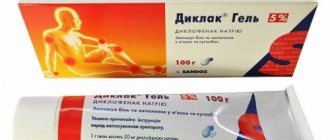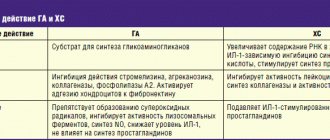Indications for use
NSAIDs are used for inflammatory diseases of connective tissue, which are accompanied by damage to joints, cartilage, tendons, ligaments - arthritis, arthrosis, osteochondrosis, spondyloarthritis, tendovaginitis, bursitis.
NSAIDs are used for conditions that are accompanied by mild or moderate pain: headache, dental, menstrual, muscle, joint, as well as pain due to muscle injuries, joints, ligament damage, neuralgia.
Together with narcotic analgesics, NSAIDs are used for multiple injuries and pain after surgery.
In combination with antispasmodics, analgesics-antipyretics are used for pain associated with spasm of smooth muscles - hepatic, renal, intestinal colic.
In addition, certain NSAIDs are used for elevated body temperature (fever) against the background of infectious inflammatory diseases of the upper respiratory tract and ENT organs (tonsillitis, sinusitis, sinusitis, otitis), lower respiratory tract (bronchitis, pneumonia), influenza and colds.
What non-steroidal anti-inflammatory drugs are most often prescribed for arthrosis?
- Aspirin is indicated in the initial stages of treatment of arthrosis and osteoarthritis, however, patients with diseases of the heart, blood vessels and gastrointestinal tract require special caution.
- Diclofenac - in tablets or ointment form.
- Ibuprofen is one of the most common medications that is easier to tolerate by the body than others.
- Indomethacin - attractive at an affordable price, relieves pain well, but it has many contraindications.
- Ketoprofen - in the form of tablets, injections, ointments, aerosols, gels, suppositories and even a preparation for applications.
- Movalis is less toxic to the gastrointestinal tract than many others, but is contraindicated in patients with diseases of the cardiovascular system.
- Nimesulide – copes with pain and inflammation, and also helps stop the destruction of joints.
- Etoricoxib requires strict adherence to the dosage, otherwise complications from the heart and blood vessels are possible.
There are a lot of drugs in the NSAID group: they must be prescribed by a doctor
pharmachologic effect
NSAIDs block the enzyme cyclooxygenase (COX), which is involved in the formation of special mediators (transmitters) of inflammation, pain and fever - prostaglandins.
COX exists in two forms: COX-1 (or physiological - is formed in the body normally; is responsible for blood flow in the kidneys, the formation of protective mucus in the stomach, blood clotting, uterine tone) and COX-2 (or pathological - appears in the body only when inflammation; responsible for the development of edema, pain, increased body temperature).
Valuable pharmacological effects of NSAIDs (anti-inflammatory, antipyretic, analgesic) are associated with inhibition of COX-2, and negative side effects (formation of stomach ulcers, thrombosis or bleeding, impaired renal function, weakness of labor) are associated with inhibition of COX-1.
What are NSAIDs
The purpose of non-hormonal anti-inflammatory drugs is to reduce and eliminate inflammation in the joints. The absence of hormones makes the effect of the medications quite mild and eliminates serious side effects. However, this is only true if the treatment of arthrosis or osteoarthritis is carried out under the supervision of a specialist.
What is the principle of action of non-steroidal anti-inflammatory drugs? How to take them correctly? Experienced doctor, chiropractor Anton Epifanov says:
Classification of non-steroidal anti-inflammatory drugs
NSAIDs are classified according to the degree of selectivity of their action on COX, as well as according to their chemical structure:
- Non-selective inhibitors of COX-1 and COX-2 (non-selectively block both COX-1 and COX-2 to the same extent): salicylates: acetylsalicylic acid, lysine acetylsalicylate;
- acetic acid derivatives: diclofenac, indomethacin, aceclofenac, etodolac, amtolmetin guacil;
- propionic acid derivatives: ibuprofen, naproxen, ketoprofen, flurbiprofen, dexibuprofen, dexketoprofen;
- fenamates: mefenamic acid.
- oxicams: piroxicam, tenoxicam, lornoxicam, meloxicam;
Nonsteroidal anti-inflammatory drugs (NSAIDs)
Nonsteroidal anti-inflammatory drugs (NSAIDs)
or
NSAIDs)
is a group of drugs that have analgesic, antipyretic and anti-inflammatory effects. Their action is based on blocking the production of prostaglandins, which are released at the site of any tissue damage. Currently, non-steroidal anti-inflammatory drugs are rightfully among the most popular drugs used in clinical practice. The most well-known NSAID is aspirin (acetylsalicylic acid). Non-steroidal anti-inflammatory drugs also include: diflunisal, lysine monoacetylsalicylate, phenylbutazone, indomethacin, sulindac, etodolac, diclofenac, piroxicam, tenoxicam, lornoxicam, meloxicam, ibuprofen, naproxen, flurbiprofen, ketoprofen, tiaprofenic acid, nabumetone, nimesulide, celecoxib, rofecoxib, mesalazine and a lot others.
The main problem with the use of non-steroidal anti-inflammatory drugs is that, being the most effective drugs in the treatment of many diseases, they also have a damaging effect on the mucous membrane of the stomach and duodenum, and both the therapeutic and damaging effects of NSAIDs are consequences of NSAID inhibition of prostaglandin production.
The main physiological functions of prostaglandins in the digestive tract are stimulation of the secretion of protective bicarbonates and mucus, activation of cell proliferation in the processes of normal regeneration and increased local blood flow in the mucous membrane. The anti-inflammatory and analgesic effects of non-steroidal anti-inflammatory drugs are due to inhibition of the enzyme cyclooxygenase (COX). There are two isoforms of COX: COX-1 and COX-2. The first of these is present in most tissues, including the gastrointestinal mucosa, and controls the production of prostaglandins, which regulate the integrity of the gastrointestinal mucosa, platelet function and renal blood flow. COX-2 plays the role of a “structural” enzyme only in some organs (brain, kidneys, bones, etc.) and is not normally found in other tissues. Its expression increases significantly under the influence of “pro-inflammatory” stimuli and, on the contrary, decreases under the influence of endogenous substances with anti-inflammatory activity. It is believed that the anti-inflammatory effect of NSAIDs depends on the blocking of COX-2, and their side effects are associated with the suppression of COX-1 (Vasiliev Yu.V.).
Nonsteroidal anti-inflammatory drugs are the cause of gastrointestinal diseases
One of the most important problems of gastroenterology is the treatment and prevention of NSAID gastropathy - diseases of the gastrointestinal tract associated with the use of non-steroidal anti-inflammatory drugs and acetylsalicylic acid.
In the late 1970s, it was found that patients with rheumatic diseases taking NSAIDs die from gastrointestinal bleeding and perforated ulcers more often than those not taking NSAIDs. Despite significant progress in the study of NSAIDs and the creation of safer drugs, modern statistics show: the risk of gastrointestinal bleeding when taking NSAIDs increases by 3-5 times, perforation - by 6, the risk of death from complications associated with damage to the gastrointestinal tract – 8 times. In 40–50% of patients hospitalized with a diagnosis of acute gastrointestinal bleeding, it is caused by taking this class of drugs. In the UK, up to 2,000 patients die annually from such complications; in the US, NSAID use is responsible for 100,000 hospitalizations and 16,000 deaths per year.
In Moscow, 34.6% of hospitalizations with a diagnosis of “acute gastrointestinal bleeding” are directly related to the use of NSAIDs. Bleeding and perforation of the ulcer are the cause of death in patients suffering from rheumatic diseases and taking NSAIDs, and account for 13.8% of the direct causes of death in patients with rheumatoid arthritis, ankylosing spondylitis and systemic lupus erythematosus (Burkov S.G.).
Clinical guidelines for the management of patients with NSAID-associated bleeding include (Russian Society of Surgeons):
- All patients requiring chronic use of NSAIDs should be stratified according to the risk of bleeding complications
- if there is a high risk of bleeding, it is recommended to transfer patients to selective COX-2 inhibitors in combination with the constant use of proton pump inhibitors or misoprostol
- if bleeding develops, NSAIDs should be discontinued (replaced with drugs from other groups); A combination of endoscopic and drug (proton pump inhibitors) hemostasis is recommended.
Materials for healthcare professionals addressing the damaging effects of non-steroidal anti-inflammatory drugs on the gastrointestinal mucosa
Articles and instructions
- Abdulganieva D.I., Belyanskaya N.E., Nasonov E.L. Relationship between clinical manifestations of NSAID gastropathy in patients with rheumatoid arthritis and motor disorders of the upper gastrointestinal tract // Scientific and practical rheumatology. 2011. No. 3. pp. 25–28.
- Vasiliev Yu.V. Proton pump inhibitors in the treatment of gastric and duodenal ulcers associated with non-steroidal anti-inflammatory drugs // Farmateka. – 2005. – No. 7. – p. 1–4.
- Nasonov E.L. The use of non-steroidal anti-inflammatory drugs and cyclooxygenase-2 inhibitors at the beginning of the 21st century // Russian Medical Journal. – 2003. – Volume 11. – No. 7. – p. 375–378.
- Agapova N.G. About drug-induced gastroduodenal ulcers // Journal “Mystery of Likuvannya”. Ukraine. – 2007. – 2(38).
- Burkov S.G. Modern approaches to the treatment of acid-dependent diseases // Breast Cancer. – 2007. – Volume 15. – No. 6.
- Guidelines for the use of non-steroidal anti-inflammatory drugs and the official instructions of Actavis Ellzabeth LCC “Diclofenac sodium extended-release tablets” for US healthcare professionals (English, pdf): “Diclofenac sodium extended-realeas tablets”.
- Official instructions from the manufacturer of naproxen drugs Year Genentech, Inc. for US patients (medical guide) “What are non-steroidal anti-inflammatory drugs? EC-Naprosyn ® (naproxen extended-release tablets), Naprosyn ® (naproxen tablets), Anaprox ®/Anaprox ® DS (naproxen sodium tablets), Naprosyn (naproxen suspension)" (in English, pdf): "Medication Guide EC-Naprosyn ® (naproxen delayed-release tablets), Naprosyn ® (naproxen tablets), Anaprox ® / Anaprox ® DS (naproxen sodium tablets), Naprosyn ® (naproxen suspension).”
On the website in the literature catalog there is a section “NSAIDs and other drug-induced gastropathy”, containing articles devoted to diseases of the gastrointestinal tract caused by taking medications and their treatment.
Video
Still from video Pakhomova I.G., Novikova D.S. Management of comorbid patients in outpatient settings. Opinion of specialists: cardiologist and gastroenterologist
Still from video Bordin D.S. A simple and effective algorithm for the treatment of acid-related diseases
Still from video Uspensky Yu.P.
GERD and other acid-dependent diseases of the digestive system. Principles of rational pharmacotherapy. On the website GastroScan.ru in the “Video” section there is a subsection “For Doctors”, containing video recordings of reports, lectures, webinars in various areas of gastroenterology for healthcare professionals.
Application. Nonsteroidal anti-inflammatory drugs in the Anatomical Therapeutic Chemical Classification (ATC)
Nonsteroidal anti-inflammatory drugs are widely used in medicine for the treatment of various diseases and conditions and, therefore, they are presented in various sections of the Anatomical Therapeutic Chemical Classification (ATC), in particular, in the section “Code M. Drugs for the treatment of diseases of the musculoskeletal system
” There are two subsections of different levels containing the following positions:
M01A Non-steroidal anti-inflammatory drugs:
M01AA Butylpyrazolidones M01AA01 Phenylbutazone M01AA02 Mofebutazone M01AA03 Oxyphenbutazone M01AA05 Clofezone M01AA06 Kebuzone
M01AB Acetic acid derivatives and related compounds M01AB01 Indomethacin M01AB02 Sulindac M01AB03 Tolmetin M01AB04 Zomepirac M01AB05 Diclofenac M01AB06 Alclofenac M01AB07 Bumadizone M01AB08 Etodolac M01AB09 Lonazolac M01AB10 Fentiazac M01AB11 Acemeta cin M01AB12 Diphenpyramide M01AB13 Oxamethacin M01AB14 Proglumethacin M01AB15 Ketorolac M01AB16 Aceclofenac M01AB17 Bufexamac M01AB51 Indomethacin in combination with other drugs M01AB55 Diclofenac in combination with other drugs
M01AC Oxycams
M01AC01 Piroxicam M01AC02 Tenoxicam M01AC04 Droxicam M01AC05 Lornoxicam M01AC06 Meloxicam M01AC56 Meloxicam in combination with other drugs
M01AE Propionic acid derivatives
M01AE01 Ibuprofen M01AE02 Naproxen M01AE03 Ketoprofen M01AE04 Fenoprofen M01AE05 Fenbufen M01AE06 Benoxaprofen M01AE07 Suprofen M01AE08 Pirprofen M01AE09 Flurbiprofen M01AE10 Indoprofen M01AE11 Tiaprofen ovalic acid M01AE12 Oxaprozin M01AE13 Ibuproxam M01AE14 Dexibuprofen M01AE15 Flunoxaprofen M01AE16 Alminoprofen M01AE17 Dexketoprofen M01AE18 Naproxcinod M01AE51 Ibuprofen in combination with other drugs M01AE52 Naproxen and esomeprazole M01 AE53 Ketoprofen in combination with other drugs M01AE56 Naproxen and misoprostol
M01AG Fenamata
M01AG01 Mefenamic acid M01AG02 Tolfenamic acid M01AG03 Flufenamic acid M01AG04 Meclofenamic acid
M01AH Coxibs M01AH01 Celecoxib M01AH02 Rofecoxib M01AH03 Valdecoxib M01AH04 Parecoxib M01AH05 Etoricoxib M01AH06 Lumiracoxib
M01AX Other non-steroidal anti-inflammatory and anti-rheumatic drugs
M01AX01 Nabumetone M01AX02 Niflumic acid M01AX04 Azapropazone M01AX05 Glucosamine M01AX07 Benzidamine M01AX12 Glycosaminoglycan polysulfate M01AX13 Proquazone M01AX14 Orgotein M01AX17 Nimesulide M01AX18 Feprazone M01AX21 Diacerein M01AX2 2 Morniflumate M01AX23 Tenidap M01AX24 Oxaceprol M01AX26 Unsaponifiable compounds of avocado and soybean oils M01AX68 Feprazone in combination with other drugs
M02AA
Nonsteroidal anti-inflammatory drugs for topical use
M02AA01 Phenylbutazone M02AA02 Mofebutazone M02AA03 Clofezone M02AA04 Oxyphenbutazone M02AA05 Benzydamine M02AA06 Etofenamate M02AA07 Piroxicam M02AA08 Felbinac M02AA09 Bufexamac M02AA10 Ketoprofen M02AA1 1 Bendazac M02AA12 Naproxen M02AA13 Ibuprofen M02AA14 Fentiazac M02AA15 Diclofenac M02AA16 Feprazone M02AA17 Niflumic acid M02AA18 Meclofenamic acid M02AA19 Flurbiprofen M02AA21 Tolmetin M02AA22 Suxibuzone M02AA23 Indomethacin M02AA24 Niphenazone M02AA25 Aceclofenac M02AA26 Nimesulide M02AA27 Dexketoprofen Back to section






